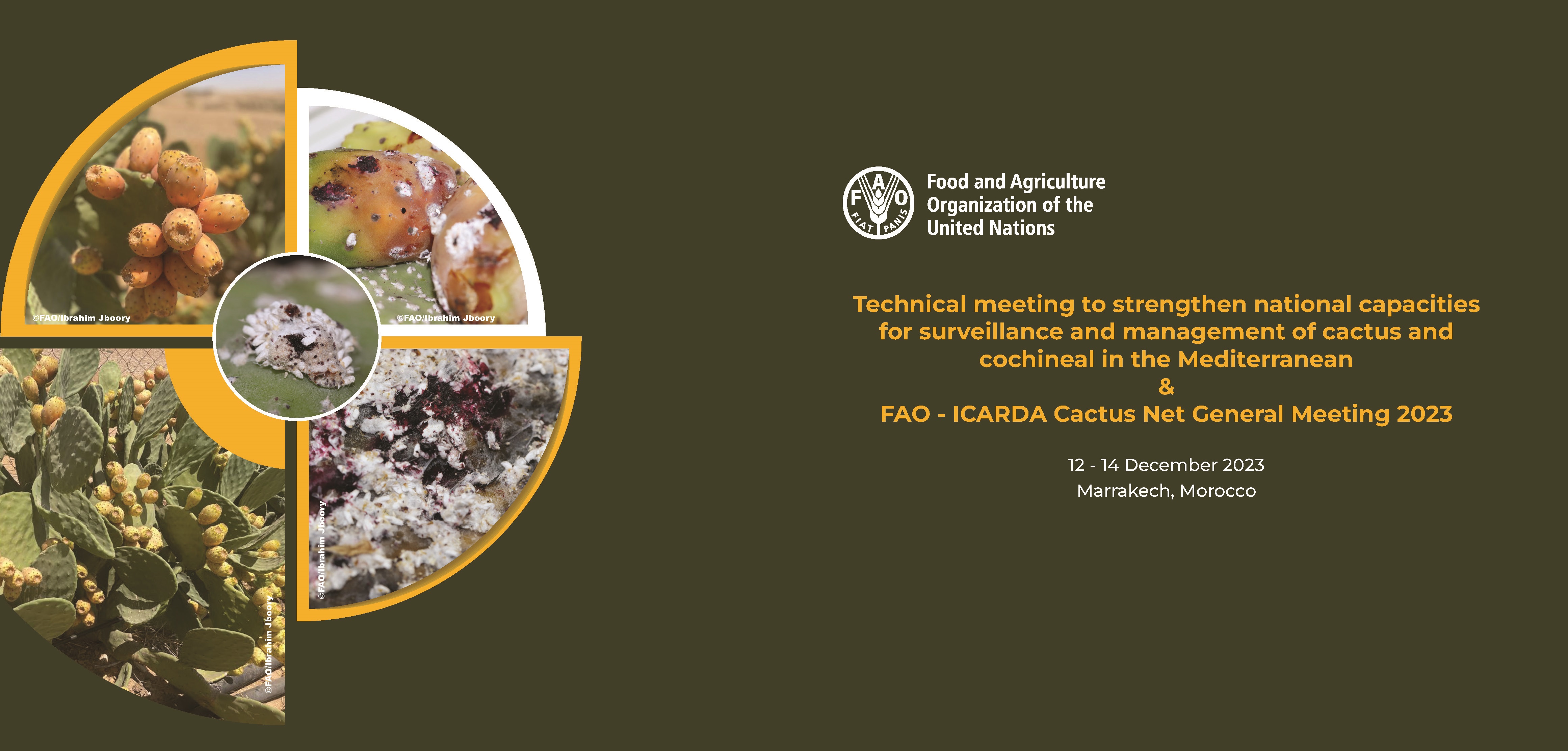Technical meeting to strengthen national capacities for surveillance and management of cactus and cochineal in the Mediterranean
FAO-ICARDA CactusNet General Meeting 2023
Marrakesh (Morocco), 12/12/2023 - 14/12/2023

©FAO
Background
Since its introduction to the Mediterranean regions, the cactus pear (Opuntia spp.) has grown to be one of the most significant species of landscape as a natural or cultivated crop. The cactus pear has gradually become an important food and feed crop for smallholder farmers, improving rural livelihoods. In Southern Europe, it is mainly cultivated for fruit production, whereas in the Near East and North Africa (NENA) region, its multiple uses as fodder, oil extraction, and medicinal and cosmetic uses are becoming popular in addition to its fruit production. It is also planted as hedges around farmlands to protect field crops, demarcating ownership rights over the lands, and protecting soil from erosion. Cactus pear plays a vital role in rural areas and contributes to the income of vulnerable communities. Cactus plantations are managed by men and women and mainly by young people.
In the last decade, invasive cochineal Dactylopius opuntiae (Hemiptera: Dactylopiidae) in NENA has left a trail of destruction to rural livelihoods and farms. D. opuntiae was first described in 1896 in Mexico and since then it has been registered in 22 countries, including Brazil, Mexico, and the Mediterranean basin countries. Cactus cochineal was reported present in Lebanon (2012), Morocco (2014), Syria (2018), Jordan (2018), and a recent infestation in Tunisia (2021). The insect infected 100,000 ha of cactus pear grown for livestock feed in Brazil, reducing productivity by 80% and causing losses of USD 100 million as well as economic and social problems for rural communities. While the economic damage in the Mediterranean remains limited so far, farmers reported that a loss in harvest increased the selling price of cactus pear.
Cochineal is a difficult pest to control due to its complex protection system; the body is covered with a thick waxy coating. The defensive mechanisms impede access to it by demanding pesticides and vital natural enemies. Mechanical control can be effective at the beginning of the infestation when the first colonies appear. National IPM (Integrated Pest Management) strategies throughout NENA are limited in controlling the spread of cochineal, as farmer awareness is still limited. The use of resistant varieties is one of the most effective ways to manage them.
The meeting will be hosted in Morocco. Morocco has been tackling cochineal management since its first discovery and has accumulated a wealth of experience in cactus production and cochineal management over the last few years.
Rationale
With the growing threat of cochineal in the NENA and its significant threat to livelihoods, greater collaboration is needed to combat and contain the spread of the pest. A recent report by FAO (2022) on the status of Cochineal and Opuntia spp. in the Near East and North Africa Region developed a NENA strategy and a road map for future actions to control the cactus cochineal in the region.
The technical meeting will bring together relevant government, academic, and private sector actors from the region – NENA and Southern Europe – to take stock of the latest situation of cochineal infestation in the region reviewing the NENA report and discuss practical actions to implement the recommendations made in the report. The meeting will be supported by a group of cactus and cochineal experts from the FAO-ICARDA International Technical Cooperation Network on Cactus (CactusNet).
A CactusNet General Meeting will be held following the technical meeting to discuss the work plan for 2024 and the next International Congress.
Objectives
- The objectives of the technical meeting are to:
- To gather the latest situation of cochineal control programmes in NENA countries.
- Agree on the mechanism for monitoring and information sharing on cochineal infestation; and
- Sharing experiences from other regions on cochineal management.
- The objectives for the CactusNet General Meeting are to:
- Report on activities per region and thematic areas
- Agree on 2024 work plan (webinars, newsletters, events)
- Plan for the next International Congress on cacti as food, fodder, and other uses
Expected Outcomes
The technical meeting will provide a clear way forward to monitor cochineal infestation in the region and contribute to controlling and managing the damage caused by the pest for the cactus production in the region.
The CactusNet General Meeting will ensure proper planning for 2024 activities and support to the 11th International Congress on cacti as food, fodder, and other uses for its successful convening.
Ultimately, the technical exchange of experts will bring broader awareness of the multiple uses of cactus and the management of cochineal for the Mediterranean region and support the conservation and use of this underutilized crop for arid and semi-arid regions.
Programme layout
The technical meeting will be attended by the countries in the NENA region that are being affected by cochineal (Algeria, Jordan, Lebanon, Morocco, Syria, and Tunisia) and the Southern European countries that are facing the threat – Italy, Portugal, and Spain. The meeting may also be observed by other countries interested in deepening their understanding of cochineal management and cactus production in general.
